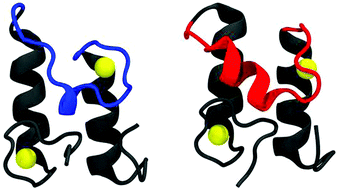Molecular simulations reveal that a short helical loop regulates thermal stability of type I cohesin–dockerin complexes†
Abstract
The cellulosome provides a fully worked out example of evolved radical nanotechnology. Improved understanding, and first steps toward re-engineering this biological nanomachine, is providing design rules for the formulation of advanced synthetic materials that can harness molecular flexibility and sticking interactions for applications in clean energy, environmental monitoring, and miniaturized devices. Computer simulations provide atomic scale insights into the mechanical stability of the component protein units, flexibility of short peptides that tether the units into scaffolds, and thermodynamic stability of protein–protein and protein–carbohydrate complexes, complementing and in some cases directing experiments. In the present work, a systematic computational study of cohesin–dockerin pairs, the strongly-bound protein complexes that glue the cellulosome nano-architecture in place, reveals that a short alpha-helix in the middle of the smaller dockerin protein becomes disordered at elevated temperatures and weakens cohesin–dockerin binding in mesophilic species. In thermophilic species, a more extensive and more thermally resistant H-bond network ensures the structure remains ordered at elevated temperatures of up to 400 K. The simulations predict that simply grafting the most crucial eight-residue peptide sequence into the mesophilic complex can, for one species and one of two possible binding modes, potentially create a new thermally resistant complex, providing leads for future experiments to re-engineer designer cellulosomes that can withstand elevated temperatures and so provide clean, renewable biocatalysts.

- This article is part of the themed collection: 2018 PCCP HOT Articles


 Please wait while we load your content...
Please wait while we load your content...